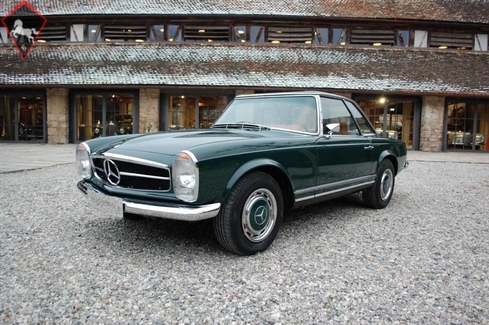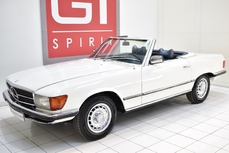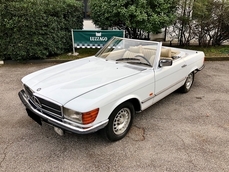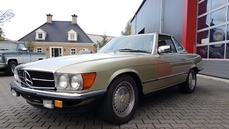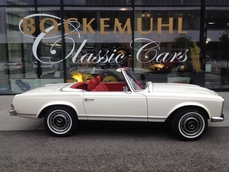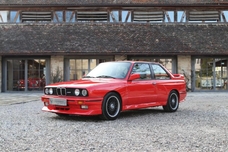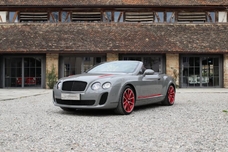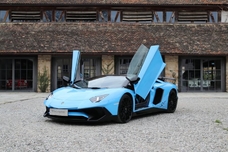Mercedes-Benz 280SL w107 SL Pagode 1970
General description :
Diese wunderschöne 280 SL Pagode wurde am 12. Juni 1969 an seinen ersten Besitzer im sonnigen Kalifornien ausgeliefert. Die Farbkombination war bereist ab Werk in Dunkelgrün mit Lederausstattung in Cognac. Neben der Servolenkung wurden zudem noch ein Becker Radio sowie ein Hardtop in Wagenfarbe geordert.
Der SL wurde dann im Jahr 2016 in sehr gutem Zustand nach Deutschland importiert und hier vollumfänglich restauriert. Das Fahrzeug besitzt sowohl matching numbers als auch matching colors und befand sich bereits vor der Restauration in sehr gutem Zustand. Trotzdem wurden hier keinerlei Kosten und Mühen gescheut um das Fahrzeug in Concours-Zustand zu versetzen. Die Karosserie ist kerzengerade und päsentiert sich mit perfekten Spaltmaßen und Passungen. Der Lack eine Augenweide und absolut glatt ohne jegliche Strukturen. Der Chrom sowie alle anderen Anbauteile wurden alle in Perfektion restauriert. Das Interieur in Vollleder Cognac passt farblich wunderbar zu dem dunkelgrünen Lack und dem schwarzen Verdeck. Der Motor, Getriebe sowie die Achsen wurden ebenso vollrestauriert. Der Gesamtzustand kann als hervorragend bezeichnet werden, da die Arbeiten sehr fachkundig und kostenintensiv durchgeführt wurden.
Wir bieten diese wunderschöne Pagode natürlich mit neuem TÜV sowie der begehrten H-Zulassung an.
This beautiful 280SL pagoda was delivered to its first owner in sunny California on June 12, 1969. The color combination was dark green with leather upholstery in the color Cognac. In addition to the power steering also a Becker radio and a hard top were ordered in body color.
The SL was then imported to Germany in very good condition in 2016 and completely restored here. The vehicle has matching numbers as well as matching colors and was already in very good condition before the restoration. Nevertheless, no expense and effort was spared to put the vehicle in Concours condition. The body is straight and presents itself with perfect gaps and fits. The paint a feast for the eyes and absolutely smooth without any structures. The chrome as well as all other attachments were all restored in perfection. The interior in full cognac color matches wonderfully with the dark green paint and the black top. The engine, transmission and axles were also fully restored. Overall, one can describe the state as excellent, since the work was carried out very expert and costly.
Of course we offer this beautiful pagoda with new TÜV.
https://www.hk-engineering.de/de/fahrzeuge/sonstige_fahrzeuge/?angebot=201
1970 Mercedes-Benz 280SL w107 SL Pagode is listed sold on ClassicDigest in Polling by Auto Dealer for €175000.
Car Facts
Car type : Car Make : Mercedes-Benz Model : 280SL w107 Model Version : SL Pagode Engine size : 0.0 Model Year : 1970 Location : Polling
Sold
Seller Information
Sold
People who viewed this Mercedes-Benz 280SL w107 also viewed similar Mercedes-Benz listed at ClassicDigest
Other cars listed for sale by this dealer
About Mercedes-Benz
In the annals of automotive history, the journey of Mercedes-Benz is a tale that unfolds with the ingenuity of its founding pioneers. In the year 1886, Karl Benz crafted the Benz Patent Motorwagen, a creation that would go down in history as the world's inaugural automobile. Unbeknownst to him, this moment marked the genesis of what would evolve into the most illustrious premium car manufacturer globally. The financial underpinning of this pioneering venture, interestingly, was provided by Karl Benz's wife, Bertha Benz, demonstrating a remarkable partnership that would set the tone for Mercedes-Benz's legacy.A parallel narrative emerged not far away, as Daimler-Motoren-Gesellschaft, founded by Gottlieb Daimler and Wilhelm Maybach, entered the scene. In 1901, they unveiled their automobile under the now-famous moniker "Mercedes," meaning "godsend" in Spanish. This name was bestowed upon the car at the behest of Emil Jellinek's daughter, the distributor for Daimler-Motoren-Gesellschaft. The wheels of innovation were set in motion.
Fast forward to 1926, a pivotal year that witnessed the merger of Daimler with Benz & Cie., culminating in the birth of Daimler-Benz. The amalgamation saw the adoption of "Mercedes-Benz" as the distinguished trademark for their automobiles, fusing the legacies of two visionary entities into one.
Contrary to perceptions of conservatism, the trajectory of Daimler-Benz unfolds as a chronicle of industry firsts. From the introduction of the honeycomb radiator to the float carburetor, and the pioneering implementation of four-wheel brakes in 1924, Daimler-Benz consistently pushed the boundaries of automotive innovation. The diesel-powered Mercedes-Benz 260 D in 1936 marked the inception of diesel engines in passenger cars. The iconic Mercedes-Benz 300SL Gullwing made history as the first car with direct fuel injection, albeit the Gutbrod's tiny 2-stroke engine can claim precedence.
Safety innovations became a hallmark, with Béla Barényi's patented safety cell design in the "Ponton"-models in 1951, featuring front and rear crumple zones. The W116 450SEL 6.9 saw the introduction of the Anti-Lock Brake system (ABS), another pioneering safety feature. From the first production airbags and beyond, the legacy of "firsts" continued to be etched into the fabric of Daimler-Benz.
Over its centennial journey, Mercedes-Benz has not merely produced cars but has sculpted automotive icons. The SSKL, 710 SSK Trossi Roadster, 770K Grosser, 540K Spezial Roadster, 300SL Gullwing, w100 600 Pullman, w111 280SE 3.5 Flachkühler, w113 230SL Pagoda, w109 300 SEL 6.3, and w201 2.3-16 Cosworth stand testament to the brand's commitment to engineering excellence.
The roaring Silver Arrows, or "Silberpfeile," including the W 25, W 125, W154, W165, and W196, created a legacy of dominance on the racetrack. These machines were not merely cars; they were expressions of precision, speed, and an indomitable spirit that left their competitors in the dust.
As Mercedes-Benz marches into the future, it does so not just as an automaker but as a custodian of a legacy, a torchbearer of innovation, and a beacon of automotive excellence. The road ahead is sure to witness the continued fusion of cutting-edge technology, timeless design, and an unwavering commitment to setting new standards in the world of automobiles.
One luminary figure who left an indelible mark was Béla Barényi, often heralded as the "father of passive safety" for his pioneering work in safety engineering. His patented safety cell design, featuring front and rear crumple zones, became a hallmark of Mercedes-Benz's commitment to occupant safety, setting new standards that reverberated throughout the automotive world.
Moving through the chronicles, the collaborative genius of Wilhelm Maybach, alongside Gottlieb Daimler, laid the foundation for Daimler-Motoren-Gesellschaft. Their innovations not only birthed the first Mercedes but established a culture of relentless pursuit of technological excellence that remains integral to Mercedes-Benz's DNA.
In the post-merger era of 1926, Ferdinand Porsche emerged as a prominent figure within Mercedes-Benz. His work on the Mercedes-Benz S-Type, a supercharged race car, garnered acclaim and set the stage for a legacy that extended far beyond the marque. Porsche's impact would later extend to his eponymous company, but his influence at Mercedes-Benz during those formative years was pivotal.
As the 20th century progressed, the legendary Rudolf Uhlenhaut emerged as a key figure. Uhlenhaut, an accomplished engineer and the driving force behind the iconic Silver Arrows, played a crucial role in Mercedes-Benz's dominance in motorsports. His engineering prowess and attention to detail were instrumental in creating some of the most formidable racing cars of the era.
In the latter half of the century, figures like Bruno Sacco, the head of design at Mercedes-Benz from 1975 to 1999, left an indelible imprint on the brand's aesthetic identity. Sacco's design philosophy, characterized by clean lines and timeless elegance, shaped iconic models like the W126 S-Class and the W201 190E, solidifying Mercedes-Benz's reputation for luxury and sophistication.
The narrative would be incomplete without acknowledging the contributions of engineers like Hans Scherenberg, whose leadership in the 1970s ushered in a new era of technological innovation at Mercedes-Benz. Scherenberg's tenure saw the development of groundbreaking technologies, including the Anti-Lock Brake system (ABS) and the introduction of airbags in production cars.
